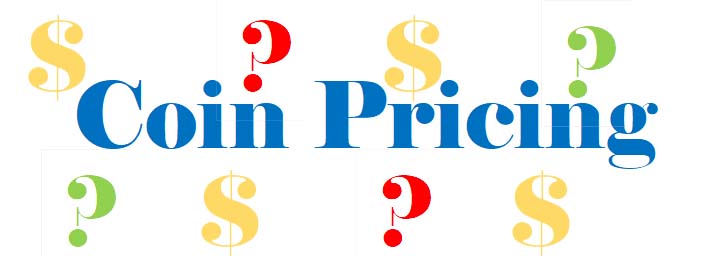Coin Pricing Caveats

Numbers printed in a price guide in rows of coin dates and mintmarks and columns of grades give the appearance of more exactitude in coin pricing than exists in reality. While a lot of coin pricing is a “science” and can be objectively applied once appropriate building blocks (such as grading) are mastered, there is also a component of coin pricing that is more of an “art” and subject to subjectivity. Here are some of the key caveats to keep in mind when pricing coins.
Grading—when using a price guide, looking for a price in the correct column is of paramount importance. This meaning knowing the correct grade of the coin. There are countless examples of coins that in one grade are worth only their face value yet in extremely high grade could be worth hundreds of dollars, thousands of dollars or even more. Scanning down the lowest grade column for higher priced coins will indicate which coins are rare no matter what their grade. Coins that are inexpensive in the lower grades but pricey in higher grades are “condition rarities." This means that although the coin is otherwise very common it is rarely seen in extremely high grade. In these cases it is imperitive that the coin actually be in high grade in order to be worth the higher price.
'Tweeners--Coins are graded on a scale of 1 to 70 but not every number on the scale is used. For example, Very Fine (VF) covers the range of grades from 20 to 39 but only 20, 25, 30 and 35 are used. If a coin is better than 35 but not good enough to be an Extremely Fine (XF) which starts at 40, then it is given the grade 35. So a coin just barely missing the XF 40 cut off will be more desireable (and thus worth more) than a coin just barely making the VF 35 grade even though both are properly graded VF 35. So, when a coin is between the grades pricing is often be impacted especially if there is a large spread in prices between the two grades.
Uniqueness—For the most part, coins are not commodities. Even two coins of the exact same type, mintmark, date, and grade are different. Whatever defects keep the two coins from being perfect, be they marks, striking characteristics, luster, eye appeal, or wear these characteristics are almost always going to be different from coin-to-coin. These differences can appeal to different preferences or aversions. If enough people share a preference or aversion, the market for coins with these differences could be different that the market for otherwise identical coins without these differences.
Originality—coins that have been improperly cleaned or otherwise had their surfaces altered in some manner are frequently worth far less than their unaltered counterparts.
Genuine—Found a rare date? The next thing to check, even before grade or value, is “Is it real?” There are a lot of counterfeit coins. In addition, sometimes real coins have been altered by changing the date or adding or removing a mint mark so that they appear to have been made in a different year or at a different mint. The more expensive, rarer, and desirable coins are the ones that are most often counterfeited and altered.
Free Market—Ultimately, a coin is worth what someone is willing to pay for it in an arm’s length transaction. This means both the person selling the coin and the person buying the coin must be in agreement as to price. This means that a lot of external factors having nothing to do with the value of the coin but nonetheless important to the involved parties can influence the value of the coin in that given situation. For example, the cash position, perceived risk, and alternative opportunities facing the two parties can influence the final agreed price. In these cases, the Coin Price Guide price is but a starting point for negotiations between the buyer and the seller.
|
Return to our Coin Price Guide Home Page to read additional Coin Pricing help topics. |


 Coin Price Guides
Coin Price Guides







